Boxscore Construction Analysis
A. Blume,Managing Editor
Adrienne.Blume@GulfPub.com
The first tanker loadings of LNG from BG Group’s $20-B Queensland Curtis LNG (QCLNG) project, located on Curtis Island offshore Queensland, Australia, began on December 28 (Fig. 1). The inaugural shipment, which set sail on January 5, marked the first LNG export from Queensland and the beginning of a major expansion of the state’s gas sector.
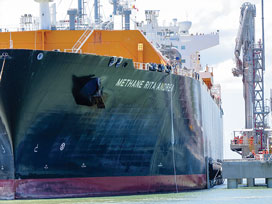 |
|
Fig. 1. LNG tanker Methane Rita Andrea loading gas |
Two other LNG projects—Santos Ltd.’s Gladstone LNG (GLNG) project and Origin Energy and ConocoPhillips’ Australia Pacific LNG (APLNG) terminal—are slated to begin exports in 2015. Collectively, the three LNG projects will make up approximately 8% of the world’s LNG production, or around 25 metric MMtpy, by the end of 2016. Gas exports from the three projects will find homes in Chile, China, Japan, Singapore, South Korea, Malaysia and other countries.
Australia boasts a number of other liquefaction projects under development around the country, leading market watchers to predict that Australia will eclipse No. 1 LNG exporter Qatar in 2018 if all projects under development are built. However, falling oil prices pushed down benchmark prices of LNG by more than 40% in 2014, which could negatively impact progress on LNG export projects in Australia and beyond.
The Queensland LNG facilities are designed to be operable for 30 to 50 years, meaning that they should withstand cyclical ups and downs in energy prices. Still, the project owners will likely be cautious in their spending in response to the ongoing price decline, which means that expansions of the export terminals may happen slower than previously projected.
QCLNG. The QCLNG project is unique in that it is the world’s first to process coalbed methane—or coal seam gas (CSG), as it is known in Australia—into LNG for export. Bechtel, the main contractor on the QCLNG project, as well as the Santos and Origin Energy ventures, reported that a total of 6,000 people worked to make the QCLNG project a reality. Construction began in 2010 and is anticipated to finish in the third quarter of this year with the startup of the second train, which will raise production volumes to 8 metric MMtpy.
Gas is sourced from the Surat Basin in southern Queensland; a 42-in., 540-km buried pipeline (Fig. 2) links the fields to Gladstone. The gas is then sent to the terminal on nearby Curtis Island for liquefaction, after which it is delivered by ship to buyers.
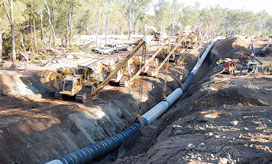 |
|
Fig. 2. The final pipe segment of QCLNG’s main |
The completed terminal will include two 4-metric-MMtpy trains, two 140-Mcm storage tanks, a marine facility for worker and equipment transportation between Curtis Island and the mainland, and marine loading facilities for LNG exports. It takes around 13 hours to fill an LNG tanker; two to three LNG tankers are expected to depart from the Gladstone harbor each week.
GLNG. In July, EPC contractor Bechtel installed the first LNG production train for Santos’ 7.8-metric-MMtpy Gladstone LNG facility on Curtis Island. Bechtel built GLNG’s first production train in 82 modules at its construction yard in the Philippines. The second train includes 29 modules, for a total of 111 modules.
The second of the $20-B project’s two trains was completed in November 2014 (Fig. 3), although the falling price of oil forced Santos to cut $50 MM in spending on the GLNG project as part of a $700-MM cut to its overall operations, the company announced in December. As of that time, the project was 90% complete and still expected to begin producing first LNG—also from CSG—in the second half of 2015. The project will use ConocoPhillips’ Optimized Cascade process to produce LNG.
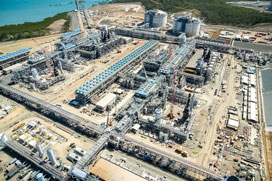 |
|
Fig. 3. Aerial view of the GLNG project’s two trains. |
Shareholders in the project include Santos (30%), Total (27.5%), Petronas (27.5%) and KOGAS (15%). A new 420-km pipeline (Fig. 4) transports gas from the Fairview, Arcadia, Roma and Scotia fields located in the Bowen and Surat Basins to the GLNG terminal. The project is being held to rigid environmental standards, particularly with regard to water treatment and discharge. LNG exports will be sent to Asian markets, including Malaysia and South Korea.
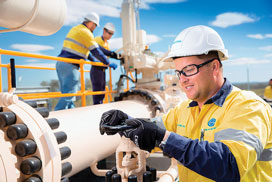 |
|
Fig. 4. First gas being loaded into the GLNG pipeline. |
APLNG. Origin Energy and ConocoPhillips’ 9-metric-MMtpy Australia Pacific LNG terminal will also use CSG as feedstock. The company stated in December that falling oil prices would impact its profits, but not its ability to fund the $20.5-B APLNG project. Origin and ConocoPhillips each own 37.5% stakes in the terminal, while Chinese state oil company Sinopec owns the remaining 25%. The project owners hope to begin exports from the APLNG terminal in the second half of 2015 (Fig. 5).
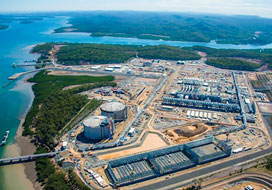 |
|
Fig. 5. APLNG is on track to deliver first LNG in |
The CSG feedstock will be sourced from the Surat and Bowen Basins in central southwest Queensland and piped to the LNG terminal via a 530-km pipeline. Construction of the LNG project on Curtis Island was nearly 90% complete as of the turn of the year. The facility will also use ConocoPhillips’ Optimized Cascade technology, combining two 4.5-metric-MMtpy LNG trains in one. Exports will be sent to China and Japan.
Australia’s LNG future. Queensland’s government expects that LNG production in 2015–2016 will spur a rise in exports that will boost the province’s economic growth by 5.75%. The projected boom in LNG output may go a long way toward helping Australia overtake Qatar as the world’s largest LNG exporter. However, high construction costs, falling oil prices and competition from US and African LNG projects are expected to test the mettle of Australia’s planned and under-construction LNG projects, including those in Queensland. GP




Comments